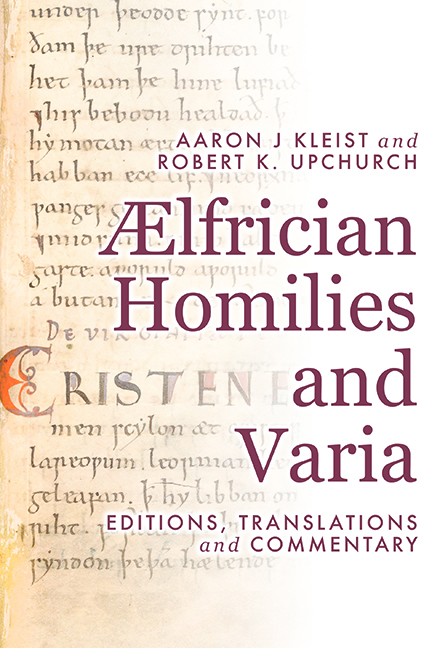Book contents
- Frontmatter
- Contents
- Preface
- Acknowledgements
- Abbreviations
- Sigla for Cited Ælfrician Manuscripts
- Dates for Cited Ælfrician Works
- Editorial Conventions
- Conventions Used in the Commentaries
- Homilies The Proper of the Season
- Homilies The Proper of the Saints
- Ælfrician Homilies and Varia: Editions, Translations, and Commentary: Volume II
- Homilies The Common of the Saints
- Homilies Unspecified Occasions
- Varia
- Works Cited
- Index
- ANGLO-SAXON TEXTS
8 - Nativity of Mary (8 September): Natiuitas sanctae Mariae uirginis (‘The Nativity of the Holy Virgin Mary’)
Published online by Cambridge University Press: 05 March 2024
- Frontmatter
- Contents
- Preface
- Acknowledgements
- Abbreviations
- Sigla for Cited Ælfrician Manuscripts
- Dates for Cited Ælfrician Works
- Editorial Conventions
- Conventions Used in the Commentaries
- Homilies The Proper of the Season
- Homilies The Proper of the Saints
- Ælfrician Homilies and Varia: Editions, Translations, and Commentary: Volume II
- Homilies The Common of the Saints
- Homilies Unspecified Occasions
- Varia
- Works Cited
- Index
- ANGLO-SAXON TEXTS
Summary
The birth of the Virgin Mary was the last of the four Marian feasts Ælfric commemorated with a homily. He had included in the Catholic Homilies (ca 992) sermons for Mary’s Purification (2 February), the Annunciation (25 March), and her Assumption (15 August), but he had refused to write one for her Nativity (8 September). He objected that the story of her birth was apocryphal and that the Gospel reading for the day, Joseph's genealogy in Matthew 1.1–16, was too hard to expound. Then, some fifteen years later, around 1005–6, for reasons he never explains, he composed the Natiuitas sanctae Mariae uirginis (‘Nativity of the Holy Virgin Mary’) and incorporated it into a revised edition of the First Series. It is the only new homily he wrote for this phase of revision, and the piece contains his first and last words on the subject such as they are.
As Mary Clayton observes, the homily ‘is remarkable in that it almost entirely avoids its supposed subject’. Of the sermon's 597 lines, only the first fifty-three deal directly with the Virgin, and only three of those deal directly with her birth [lines 21–3]. Ælfric begins by resorting to the authority of ‘wise teachers’ to reject the apocrypha surrounding her birth and death [lines 2–10]. Of her earthly life, he mentions only that the righteousness of Mary's parents allowed them to beget the child who bore the Savior, that Mary was born to be the mother of the incarnate Lord, and that she in turn bore the God-man Christ [lines 11–29]. Ælfric then turns to her feast-day. He explains that the great honors with which Mary came to mankind allow them to come to her for intercession, and he comments on the exceptional nature of celebrating her human birthday when all other saints except John the Baptist and Christ are remembered on the day they were born into eternal life [lines 30–49]. He concludes somewhat summarily by expressing a desire to offer some profound ‘holy teaching’ as a form of encouragement on the celebratory feast-day [lines 50–4].
The teaching Ælfric offers focuses on virginity rather than the Virgin, and its contours follow Augustine's treatise De sancta uirginitate (‘Concerning Holy Virginity’), the title of which supplies a name for part two of the sermon [lines 55–599].
- Type
- Chapter
- Information
- Ælfrician Homilies and VariaEditions, Translations, and Commentary, pp. 423 - 485Publisher: Boydell & BrewerPrint publication year: 2022

